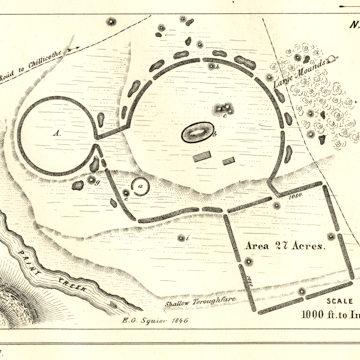Originally Seip Earthworks enclosed 121 acres with 10,000 feet of embankment walls that rose up to 10 feet high. These earthen walls, some with regularly spaced openings, formed a connected square, circle, and semicircular shape. Enclosed within these walls were several mounds including the largest, Seip I mound, measuring 240 feet long, 160 feet wide, and 30 feet tall. Within the enclosure are three smaller conjoined mounds and several small individual mounds. Excavations of the site have revealed post holes, evidence of wooden shelters. Outside the embankment walls were additional mounds. Much of the extensive earthworks site has been negatively impacted by cultivation practices but the entire complex remains visible from the air.
References
“Hopewell Culture, National Historical Park, Ohio.” National Park Service. Accessed November 20, 2018. https://www.nps.gov/.
Lepper, Bradley T. “Archaeology of the Hopewell Culture.” In Encyclopedia of Global Archaeology, edited by Claire Smith. New York: Springer New York, 2013.
Lepper, Bradley T. Ohio Archaeology: an illustrated chronicle of Ohio's ancient American Indian cultures. Wilmington, OH: Orange Frazer Press, 2005.
Lynott, Mark J. Hopewell Ceremonial Landscapes of Ohio, More than Mounds and Geometric Earthworks. American Landscapes Series. Havertown, PA: Oxbow Books, 2015.
Squier, Ephraim G., and Davis, Edwin H. Ancient Monuments of the Mississippi Valley.1848. Reprint, Washington D.C.: Smithsonian Institution Press, 1998.
Weiss, Francine, “Hopeton Earthworks,” Ross County, Ohio. National Historic Landmark Nomination Form, 1975. National Park Service, U.S. Department of the Interior, Washington, DC.
Weiss, Francine, “Mound City Group National Monument,” Ross County, Ohio. National Historic Landmark Nomination Form, 1975. National Park Service, U.S. Department of the Interior, Washington, DC.





